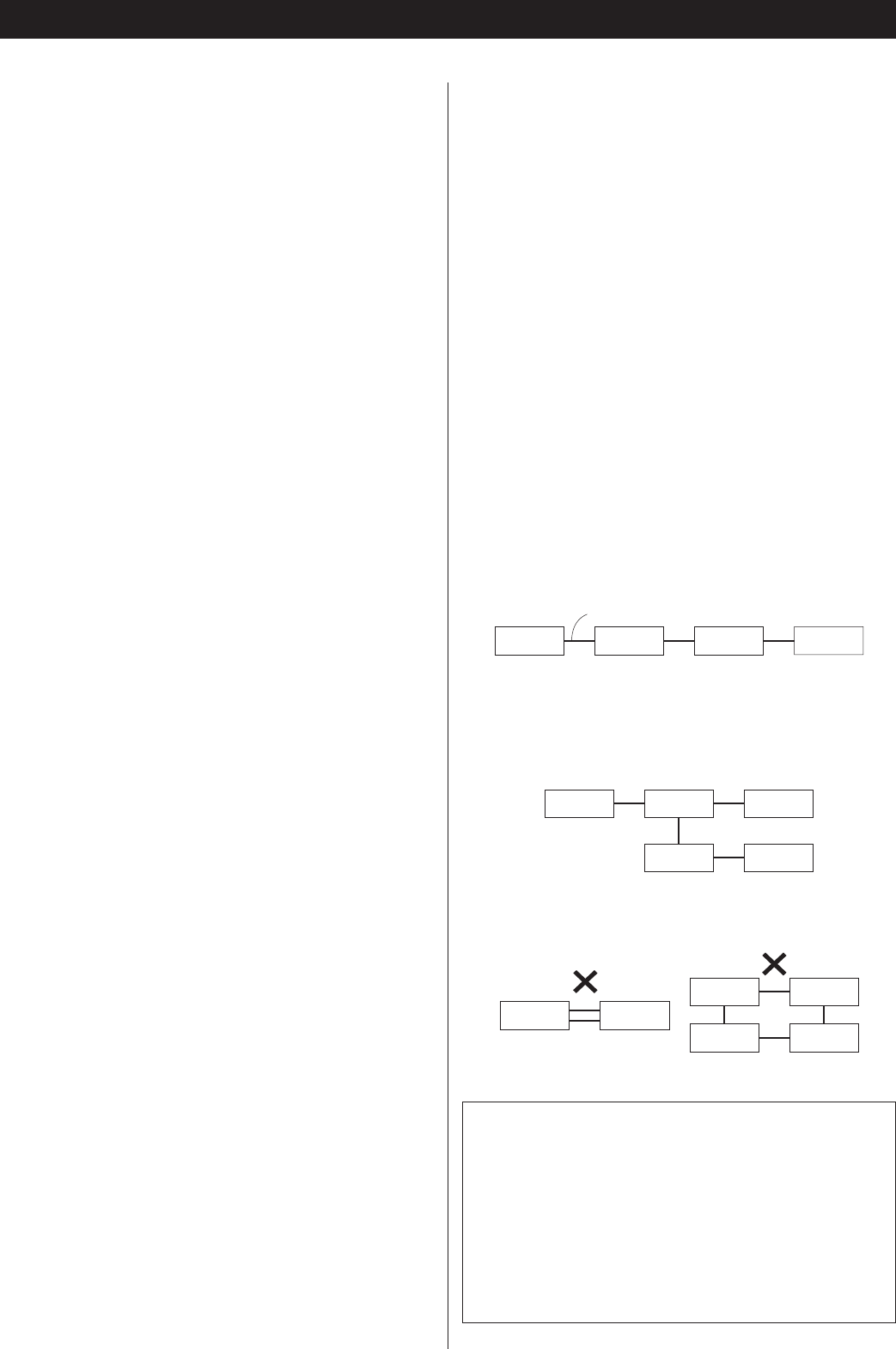
8
i.LINK (IEEE 1394)
i.LINK is also known as IEEE 1394, an international specification.
This unit is ready to accept i.LINK (AUDIO).
By connecting an i.LINK (AUDIO)-capable device to the IEEE
1394, or i.LINK (AUDIO) terminal on this unit using an i.LINK
cable, you can transmit Super Audio CD multi-channel signals
that could not be transmitted except in analog format in the
past. Now a Super Audio CD digital signal can be transmitted in
its original digital format in addition to transmitting 2-ch linear
PCM data and multi-channel compressed audio signals.
If you have multiple i.LINK-capable devices, you can connect
them through other devices to transmit data between them, so
you don’t need to be concerned with the order of connection.
Copyright protection system DTCP
To play back audio sounds recorded on Super Audio CD or DVD
discs using i.LINK, both the player and the D/A converter need to
be ready for the copyright protection system DTCP (Digital
Transmission Content Protection).
This unit is equipped with DTCP.
Data transfer rate
There are three transfer rates using i.Link: 100 Mbps (S100), 200
Mbps (S200), and 400 Mbps (S400). This unit is capable of
transferring data at the maximum 400Mbps.
For connection to an i.LINK-capable device, use a commercially
available S400-compliant 6-pin i.LINK cable.
When connecting multiple i.LINK-capable devices, avoid
connecting a device having slow transfer rate between devices
having high transfer rate since this reduces the transfer rate of
your whole system. Connect devices having high transfer rate
towards the source as far up-stream as possible.
NOTES
<
Among the i.LINK formats there are “MPEG-2 TS” for BS
digital source and “DV” for digital video for DVD recorders,
as well as the “i.LINK (AUDIO)” (A&M Protocol). Never
connect devices that are not ready for i.LINK (AUDIO) to this
unit. If you do, this unit and others may get erroneous data
or be damaged.
<
Avoid plugging or unplugging the i.LINK cables while the
player is in use. Preferably, make all connections when the
power is off.
<
Among the i.LINK-capable devices there are some that, if not
turned on, are not capable of relaying data.
< There is a possibililty some i.LINK-capable devices will not
respond to this unit's command.
How to connect multiple i.LINK-capable
devices
Daisy-chain connection
You can daisy-chain up to 17 devices including this unit.
Connection in tree structure
If you are using a device having three or more i.LINK connectors,
you may want to get the connection branched out. This way of
connection allows you to connect up to 17 devices including this
unit.
Your system will not work if data is fed back to the original
output device.
Be careful not to create a loop.
i.LINK-capable
device
i.LINK-capable
device
i.LINK-capable
device
i.LINK-capable
device
i.LINK-capable
device
i.LINK-capable
device
i.LINK-capable
device
i.LINK-capable
device
i.LINK-capable
device
i.LINK-capable
device
i.LINK-capable
device
i.LINK-capable
device
i.LINK cable
i.LINK-capable
device
i.LINK-capable
device
i.LINK-capable
device
The i.LINK interface of this unit is designed in accordance with
the following specifications:
1)IEEE Std 1394a-2000, Standard for a High Performance
Serial Bus
2)Audio and Music Data Transmission Protocol 2.0
This unit is compliant with IEC 60958 bitstream, DVD-Audio,
Super Audio CD in the AM824 sequence adaptation layers of
this protocol.
Flow rate control
This unit supports i.LINK flow rate control. Flow rate control
means that audio data transferred via i.LINK is first stored in
RAM of this unit after which the high-precision clock in the unit
is used to retrieve the data from RAM to avoid the transfer jitter
normally associated with i.LINK transfer. This unit transfers
commands to the playback device to change the data transfer
rate and control the playback device when data accumulated in
RAM exceeds or goes below a certain amount due to differences
in clock frequencies in the playback device and this unit. Flow
rate control functions in transfers between this unit and another
unit.


















